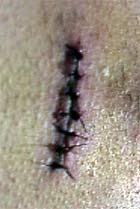Sutures
A thread-and-needle-based wound closure device.
Sutures ("stitches") are used to sew wounds shut and repair various kinds of damage.
Suture are identified first by type (absorbable or non-absorbable).
Absorbable sutures break down in the body. They include plain and chromic gut, as well as polyglactin ("Vicryl"), polyglycolic acid ("Dexon"), and polydioxanone ("PDS II") sutures. The organic sutures are broken down by enzymatic processes, whereas the synthetics are broken down via hydrolysis. These types of sutures are generally only used internally or on parts of the body that heal quickly.
Non-absorbable sutures do not break down and must eventually be removed. They include silk, polyester ("Ethibond", "Tevdek"), stainless steel wire, polypropylene ("Prolene", "Fluorofil"), and polyethylene/nylon sutures ("Ethilon", "Nurolon"). Non-absorbable sutures are encapsulated by the body's fibrolasts. These types of sutures are best for slower-healing body tissues (like skin).
Sutures are sized numerically, in the opposite sizing from body jewelry (that is, 9 is huge, and 9-0 ("000000000") is microscopic). 0 and 2-0 are the average sizes used in surgery, with 3-0 and 4-0 generally reserved for subcutaneous use. Larger sutures (2 and up) are used for jobs like abdominal repair, while smaller sutures (5-0, 9-0, etc.) are used for vein repair and opthalmic repair. If scarring is to be minimized, the smallest possible sutures should be used (too small, though, and they'll cut through the skin).
In addition, sutures may be monofilament (a single strand) or braided (made up of multiple strands); the latter generally has better handling characteristics. However, braided sutures also create a greater response from the body, and should not be used in contaminated wounds, as they can contribute to infection.
Different types of sutures have different properties as far as the way the body reacts to them, as well as handling characteristics, including how much slippage should be expected in knot tying.
